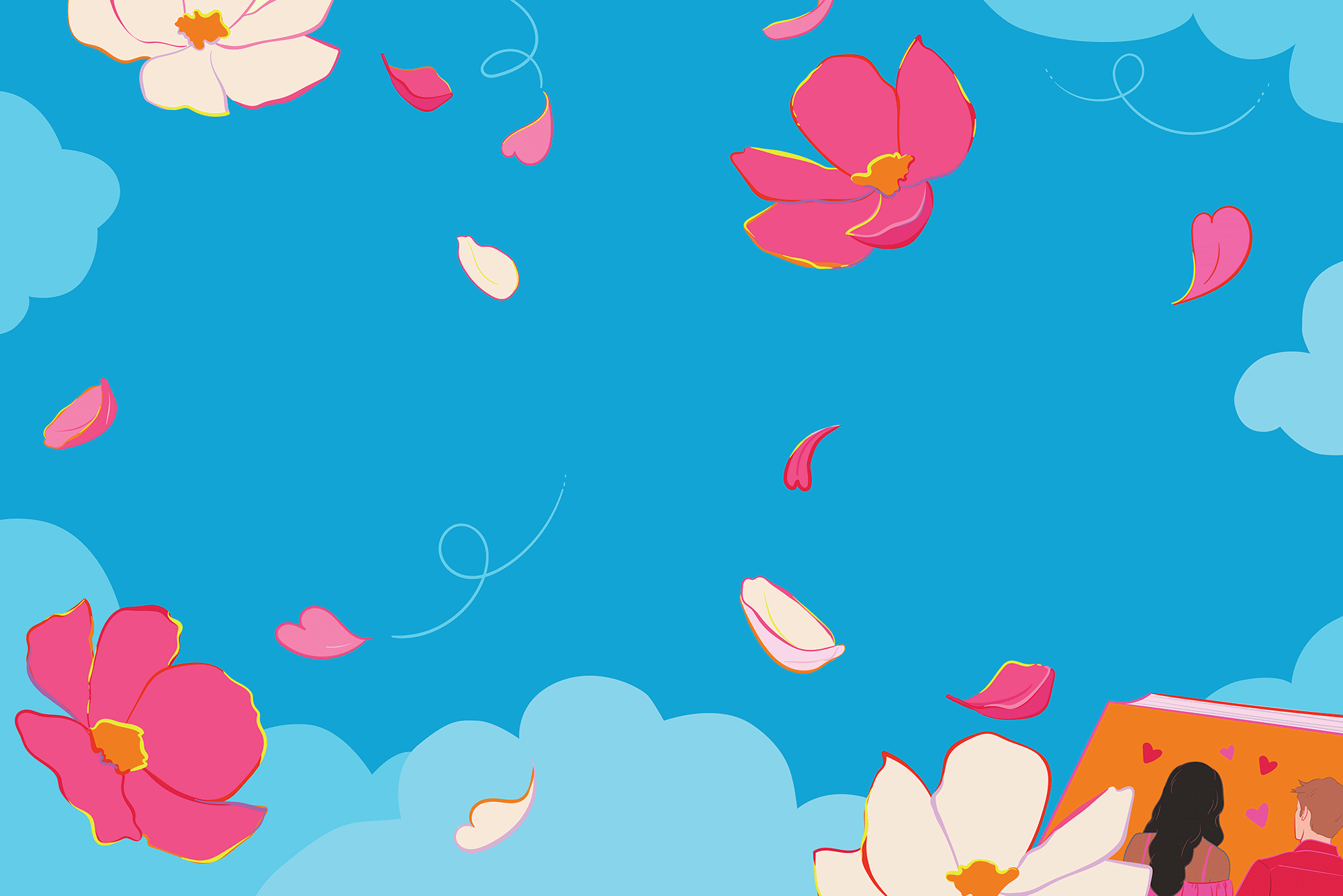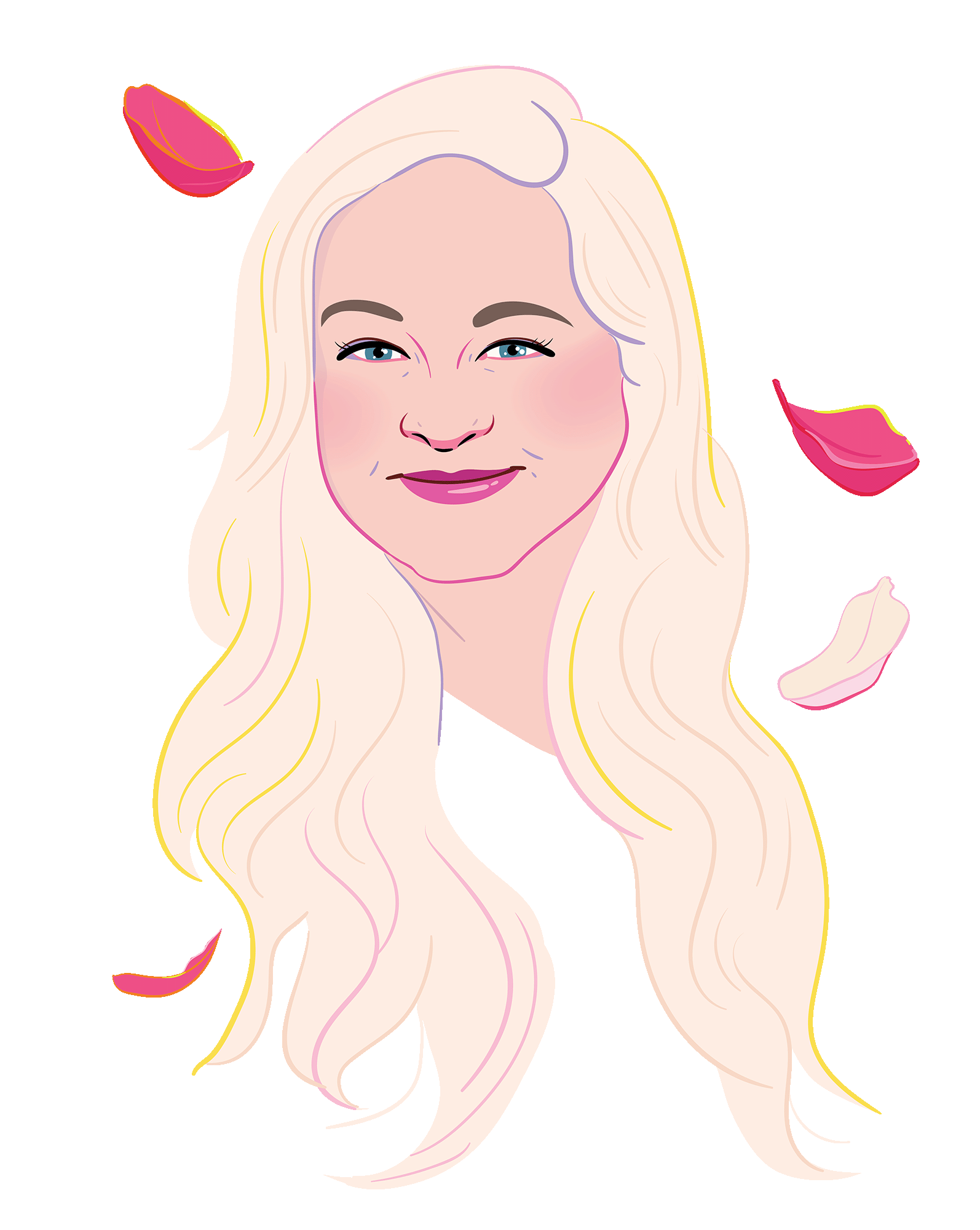Love Is in the Air—and on the Page. Alum Authors Are Helping to Fuel a Romance Fiction Boom.

Illustrations by Mallory Heyer
Love Is in the Air—and on the Page
Writing with a little sweetness—and a little spice—these Boston University alums and authors are helping to fuel a rise in romance fiction
Enemies to lovers. Opposites who attract. Rekindled flames. Casual hookups grown deeper. A maybe-not-so-straight crush. Vacation flings turned year-round love affairs.
The literary romance tropes abound—and, turns out, we eat them up.
Romance literature, once considered a guilty pleasure, is having a moment in the sun. The genre’s bright, breezy covers grace bookstore shelves around the world—including at a new crop of romance-only bookstores, like Harvard Square’s Lovestruck Books. If you look at readers on the beach or the bus, odds are you’ll clock at least one with their nose in a coyly titled book. (Giggling, blushing, and kicking feet sometimes, but not always, included.)
Romance is a juggernaut industry. While the genre has always had devoted readers, romance was the fastest-growing print book market for 2025 as of June, according to the consumer analytics firm Circana. A staggering 51 million units had sold in the previous 12 months.
And that’s a good thing for romance writers—predominantly women—who report increasingly high earnings compared to other genres. That’s in part because those authors were early adopters of digital publishing, writer Christine Larson explained in a 2024 NPR interview. Publishing in e-book and PDF formats allows authors to keep more of their earnings compared to print books, said Larson, author of Love in the Time of Self-Publishing: How Romance Writers Changed the Rules of Writing and Success (Princeton University Press, 2024). And sometimes, Hollywood comes calling. In addition to selling millions of books, Emily Henry—author of back-to-back bestsellers like Beach Read (Berkley, 2020) and People We Meet on Vacation (Berkley, 2021)—has development deals for almost all of her romance titles, according to the New York Times.
As for who’s knocking back these titles: Romance readers skew heavily female—up to 82 percent, according to a study commissioned by the trade association Romance Writers of America—and younger, often in their 30s and under.
Why do we love to read about love?

“I think there is so much good to be had from having this avenue for safe, healthy, happily-ever-after escapism,” says Kimberly Swiszcz (LAW’16), author of a romance series set in the fictional New Hampshire lake town of Wilcox Grove.
Swiszcz is one of a crop of BU’s romance and romance-adjacent alumni authors, which includes best-selling novelist Kate Quinn (CFA’04,’06) and author and sociologist Patricia Leavy (CAS’97), who published Cinematic Destinies (She Writes Press, 2025), the finale in her Red Carpet Romance trilogy, in September. (Another Boston University connection: The Special Collections of the BU Libraries holds the papers of the late, famed romance novelist Barbara Cartland, along with many others who have written in the genre. Cartland wrote more than 700 books.)
“Our world is on fire, and it’s not always fun to be in,” Swiszcz says. By definition, a romance novel has to end with a happy resolution. “These books give you a place to go when you need peace. Sure, you may have some turmoil [in a story], but it’s going to be okay in the end. And that helps us look around at what we have and say, ‘Maybe it’s going to be okay here too.’”
Lauren Eckenroth, a regular romance reader, agrees. She returns to romance titles for the ease and comfort she finds in them, she says.
“The protagonists are often in or coming out of some messy-but-relatable personal circumstances, there’s a lot of emphasis on the characters’ emotional growth, and, in most cases, there’s a satisfying resolution,” says Eckenroth (GRS’12,’20), director of alumni marketing and communications at Boston University, who has a PhD in literary modernism, textual criticism, and documentary editing from BU’s Editorial Institute. “The world is hard, but I know when I pick up a romance novel there will always be a happy ending.”
Then, of course, there’s the spice factor.
Vivid descriptions of—or winking allusions to—steamy sex are part and parcel of romance novels. For many readers, the spice (as it’s commonly referred to in the literary romance world) is the prize that keeps them turning pages.
Even those romance stories, Swiszcz says, are all about exploring sexuality in a consensual, accepting, guilt-free way. “There are some that will try to guilt you about it,” Swiszcz says, “and to them, I say, ‘Go away. It’s not for you!’”
Romance as Comfort
“I always smile because it seems this comes up every few years, that romance is having a moment,” Quinn says. “But romance novels are some of the most lucrative titles that keep publishing houses afloat.” (There’s a reason Pride and Prejudice, published in 1813, has had so many film and TV adaptations—including a forthcoming Netflix series—and received consistently rave reviews on Goodreads and Google Books.)
Interest in romance often surges during times of trouble, Quinn says. She cites the COVID-19 pandemic as a huge boon for the genre. “People read romance and watch rom-coms for that warm bath of reassurance that, no matter how sad or dark things are, the couple is going to be fine,” she says. “That is really comforting, whether you’re living through a pandemic or a period of extreme political upheaval, or whatever you’re going through.”
Quinn’s hit historica fiction novels include The Alice Network (William Morrow Paperbacks, 2017), where two women’s lives intersect amid the back-drops of World Wars I and II; The Huntress (William Morrow Paperbacks, 2019), a Nazi-hunting page-turner set in the aftermath of World War II; and The Briar Club (William Morrow, 2024), a tale of female riendship and betrayal during the paranoia of the McCarthy era. She’s not a romance author by definition—writing about history, she says, she can’t guarantee you a happy ending—but her work always has strong romantic themes.
“I always have a romance in [my stories],” Quinn says. And in her reading habits, “I tend to gravitate back toward romance in dark times. It’s all about that comfort you get from seeing a couple on page one who hate each other, but who you know will work their way towards each other at the end, and enjoying the ride.”
Mystery is another high-selling genre with a familiar, comforting formula. Author Corrina Lawson (COM’87) has combined the two genres, publishing Burying the Lede (City Owl Press, 2025), the second entry in her romantic suspense series, in July.
“Real life presents us with its own mysteries, and doesn’t give us easy answers,” Quinn says. When you read a mystery, “you know by the end who did it, and, generally, justice triumphs.”
But only one genre has gotten a bad rap. That’s because romance, unlike mystery, is written and consumed mostly by women. “Therefore, it’s considered a ‘women’s industry,’” Quinn says, “and gets bashed for that” by literary critics and readers alike.
Those critics and consumers are ignoring the fact that crime reads are often just as smutty as romance. “There’s the noir detective, and then there’s the leggy blonde who shows up and falls into his arms immediately,” Quinn says. “And, somehow, that does not get the title of ‘wish fulfillment’ like the book about the girl who gets romanced by a duke does.”
Becoming Kim Swizz
Swiszcz’s journey to authorship reads like something out of one of her novels. (Swiszcz publishes under the name Kim Swizz.)
After graduating from BU, she spent eight years working in tax law and private equity. The career experience was valuable, Swiszcz says, but it wasn’t exactly “filling the cup.” So she gave notice and enrolled in an online master’s program in library science.

A lifelong reader and writer, she imagined herself as a librarian for her second act. But during the last semester of the program, she was visiting a friend on Lake Winnipesaukee in New Hampshire. The two were sitting on the back porch, eating hot dogs, and Swiszcz suddenly had a vision: A woman walks out the back of her lake house, where she finds a man in the shed next to her dock. She thinks he’s a ne’er-do-well and does the only logical thing you can do in that scenario: threaten him with a frying pan.
“And that was how I met Alice and Jake from my first book,” she says of Barefoot Lake (Kimberly Swiszcz, 2024).
From there, the stories poured out. The second installment in her Wilcox Grove series, In the Stars Rewritten (Kimberly Swiszcz, 2025), published in June. A third book, the last in the series, is in the works.
For Swiszcz, now a full-time romance author, a large part of what keeps her writing—and reading—is the community.
There’s a massive community online—such as on BookTok, the literary subcommunity of TikTok—ready to gush over titles and come to each other’s defense against the haters, of which there will always be plenty for a female-dominant genre, Swiszcz says.
“Strangers online will have your back so fast, and it’s wonderful,” she says. “I’ve met some of my best friends through romance books.”
An Evolving Genre
Despite its formulas, romance still has room for evolution and surprise. Over the years, the genre has reflected more modern sensibilities. Today’s reads aren’t your mom’s “bodice rippers,” where young, frail (white) women are powerless to resist a rugged (white) man’s advances. Now, in an era when women and minorities have more agency, our romances often embody that.
Today’s reads aren’t your mom’s “bodice rippers,” where young, frail (white) women are powerless to resist a rugged (white) man’s advances.
For one, the power dynamic between the sexes is far more balanced than in the past. (Cue the “career gal” as another popular romance trope.) Consent is also a focal part of many sex scenes and dynamics between characters. And today’s crop of romance books is far more diverse. Take the success in recent years of titles like Casey McQuiston’s Red, White & Royal Blue (St. Martin’s Griffin, 2019), in which the son of the president of the United States falls for his former rival, the Prince of Wales, or Jasmine Guillory’s The Wedding Date (Berkley, 2018), which features an interracial romance between Alexa, a Black chief of staff, and Drew, a white pediatric surgeon. Or there’s Helen Hoang’s debut, The Kiss Quotient (Berkley, 2018), where the autistic Stella hires a handsome escort to help her practice dating rites and, uh, other things.
Another development in recent years: the capital-E explosion of romantasy—combined romance and fantasy, for the uninitiated.

Books by fantasy author Theodora Goss (GRS’06,’12), a master lecturer in BU’s College of General Studies, include the Extraordinary Adventures of the Athena Club series, in which the daughters of notorious fictional characters and monsters team up to solve mysteries; and Snow White Learns Witchcraft (Mythic Delirium Books, 2019), a collection of fairy-tale retellings in short stories and poems.
Romantasy isn’t new, Goss says, citing pioneering fantasy authors like Patricia McKillip, Tanith Lee, and Anne McCaffrey, whose works often had central romances. But modern, megahits like Sarah J. Maas’ A Court of Thorns and Roses series and Rebecca Yarros’ Empyrean trilogy have placed the subgenre in the spotlight.
One explanation: Romantasy is the ultimate escapism. No romantasy novel would be complete without an elaborate imaginary world. Like J.R.R. Tolkien’s beloved Middle-earth, Maas’ faerie kingdoms and Yarros’ college for dragon riders are lush worlds that carry us to a place where anything can happen.
“I’m going to professor you a little, but Tolkien gave a famous speech that he turned into a written essay on defense of fairy tales and fantasy,” Goss says. “In it, he says that fantasy specifically gives us these alternative possibilities; it allows us to imagine different pasts, but also different futures.”
Fantasy also offers us renewal, according to Tolkien. “He said that it allows us to come back to our own realities refreshed, and to look at them in a different way,” Goss says. “Imagine that you’re a romance reader who works in HR, having to deal with managing people’s problems all day. You come home, sit in a bubble bath, and read one of these romantasy books—maybe that allows you to see more potential in the world than there was before.”
Another plus, Goss posits: These romantasy series are largely set in either early-technology or alternative-technology worlds—a welcome departure from our hyperplugged-in reality. (There’s definitely no Bumble in the faerie realm. And swiping seems beneath a dragon rider, in general.)
But maybe it’s simpler than that: Isn’t love its own type of fairy tale?
“Romance is a kind of fantasy, right?” Goss says. “You fall in love and you enter this magical world where everything’s brighter, and you’re like, ‘Oh, it’s true love!’ Romance just naturally gets you away from reality. So they’re two genres that fit really well together.”
Readers Get It
“I don’t know of a single romance author who hasn’t received a fabulous fan letter that reduced them to tears, saying something along the lines of, ‘I read so many of your books while I was in the chemo lab with my mom,’ or, ‘I read so many of your books when I was going through a personal crisis,’” Quinn says. “I think that’s why it’s evergreen; people want that reassurance that love will triumph and life will be okay.”
Romance doesn’t need to be for everyone, Swiszcz says. “People who want to hate it are always going to hate it,” she says. But plenty more readers get it.
“These stories are whatever someone needs them to be,” Swiszcz says. “Some of them are just fluffy fun and some of them are smutty fun and some of them are the most emotionally destructive and rebuilding, twisty-turny, tear-you-apart, make-you-reconsider-the-entire-world, existential-crisis-inducing books wrapped in a love story.
“I don’t want that in every single book,” she adds, “and I don’t get that in every single book. But those stories are there, and they’re powerful.”
Do you love romance novels? Email us at bostonia@bu.edu and tell us why!